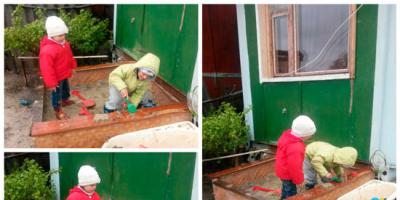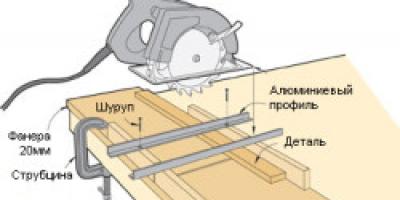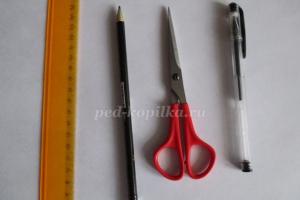If you are the owner private well, then your site has an individual water supply and thus you do not depend on anyone. But as soon as you encounter a problem called “no water in the well,” all worries fall on your shoulders. Because you are the only person making a decision regarding your water intake source and identifying the reason why this happens.
What to do if the water in the well comes in jerks, if there is little water in the well or there is none at all, we will discuss below.
Possible problems with the source
The most common problems that can arise with a well and the presence of water in it are:
- Reducing the water level in the well (partial, periodic or permanent);
- Drying out of the well (meaning the complete drying of the well or a situation where water can quickly run out);
- The water supply to the water supply system is jerky.
It is important to remember: the occurrence of such problems can often be the result of improper drilling and source management. Therefore, it is always necessary to invite experienced professionals to carry out work.
If the water level in the well drops
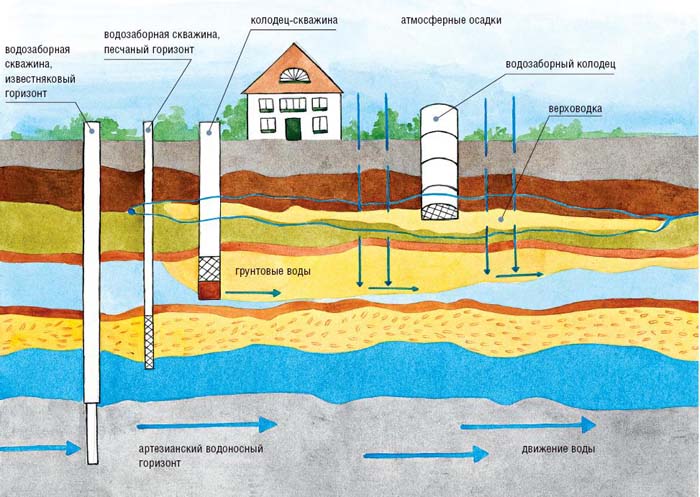
You all year round Are you using your well and have never noticed a lack of water in your home before? Are you faced with a situation where the water in the well quickly runs out or periodically there is no water at all to the bottom level? Why did this happen? Let's deal with possible reasons and ways to fix the problem. The main prerequisite for such source behavior may be:
- Natural change in geological conditions at the location of your well. That is, there is a displacement of the bottom of the formation from which you draw water).
- Aquifer changes according to the season (most often in the summer the layer can decrease, in the cold season it can increase).
- Defects made during the construction of the well or during its operation (here we mean the well is not deep enough, the rings are not sealed, cracks appear, an incorrectly selected filter, etc.).
- Silting of filters(if the well has not been used for a long time).
Important: all of the above possible problems are taken into account if professionals are working on the well. When self-execution work, a design error may be made in the arrangement of the flask.
The reasons for changes in the water level in the well can also be third-party factors, such as:
- Carrying out drilling operations in close proximity to your well;
- Connecting another user to the horizon from which you draw water.
- In this case, you need to wait a period of 25-30 days, and if the water level in your well does not return to its usual state or the phenomenon repeats periodically, then you can raise the question of deepening the well. Especially if the initial depth of the well does not even exceed 10 m.
Important: deepening the well should only be done after a thorough analysis and identification of the causes of the situation.
The decision to deepen the well will be relevant in the following cases:
- If in general you are only confused by the water level, but its quality completely suits you.
- If drilling a new well is not suitable for you due to lack of free space on the site.
- If no horizontal displacements are detected between the rings of the well and the bulb itself is not bent.
If the water is completely gone
This phenomenon often happens if your well is no longer new and has been in operation for more than three years. Often such a well, dug to the level of the high water, produces either a small volume of water over time, or the water in it runs out (dries up) completely. The reason is the work of the aquifer at two or more points or its drying out. In this case, you need to either make (drill) a new well (or better yet, an artesian well), or deepen the old one to a depth of more than 10 meters. The decision is made based on financial capabilities and the available area of the site.
Water flow in spurts
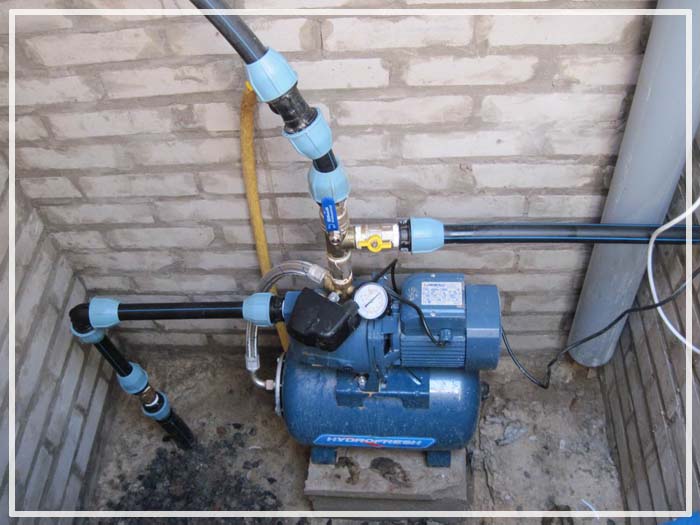
If the water pressure in the water supply system from the well changes periodically, this indicates a change in the pressure force in the communication (that is, the pressure has dropped). It is only necessary to calculate at which level of the structure pressure fluctuations occur: at the level of pumping equipment, when water enters the pipe, or exclusively at one water supply point.
You need to figure it out by elimination. First, you should check all the points in the house by turning on the water. If the water comes in jerks and there is no good constant pressure at all points, then the problem is in the pipe connected to the house. In this case, air along with water can enter the pipe and a kind of air plug is obtained, which prevents water from flowing with constant pressure.
And yet the most common reasons, according to which the water pressure in the system changes and it flows in jerks, can be as follows:
- Insufficiently good tightness of the entire water intake system. It is necessary to check the operation of communication in all its sections from the pump hydraulic tank to all pipes.
- Breaking check valve pump or other moving parts of pumping equipment.
- Debris getting into the pump. In this case, the pressure rises too quickly when the unit is turned on and the pump switches off. Once the pressure drops again, the pump turns on. In this case, the water comes in jerks. The pump needs cleaning and filter replacement.
- Insufficient amount of water in the well or incorrectly selected pump immersion depth.
- Rupture of the pump hydraulic tank membrane. In this case, the pump may also become contaminated with small particles of debris. The hydraulic tank requires replacement to continue the operation of the well and normalize the pressure in the system.
- Or it may happen that air has escaped from the hydraulic tank for natural reasons. In this case, it must be pumped up with a simple bicycle pump. After this procedure, the pressure in the system returns to normal, and the water flows again with a normal constant pressure.
From all of the above, it is worth drawing conclusions that the construction of a well should be carried out at the level of professionals. They will accurately calculate the flow rate of your aquifer, the productivity of the well and the duration of its operation, and also select the optimal equipment. And in order not to encounter such problems when constructing a well on the upper aquifers, it is best to immediately drill an artesian well.
2014-01-29 00:00:00
A sudden lack of water in your well may not be a pleasant surprise.
Very often it happens like this:
It seems that a well was drilled just recently, the drillers promised that it would work for twenty years, but it was empty. Most often, not suddenly, at first the water flowed somewhat cloudy, then completely dirty, with a large admixture of clay, began to flow slower and slower, and then disappeared completely. This happened due to the fact that, most likely, the well silted up, since it was doomed from the very beginning - the drillers who drilled it simply either cheated, or simply did not want to, or could not do it correctly - in two columns.
Almost any wells, if they are not made for sand, be it not deep twenty meters  wells, either deep over a hundred meters, should be drilled in two or even three columns. This is done in order to cut off the upper layers of unstable soil, since various quicksand, loams and silty mud, flowing down the outer walls of the well casing, settle at the bottom of the well, clog the sump and the entire well, so that sometimes even the pump cannot be pulled out.
wells, either deep over a hundred meters, should be drilled in two or even three columns. This is done in order to cut off the upper layers of unstable soil, since various quicksand, loams and silty mud, flowing down the outer walls of the well casing, settle at the bottom of the well, clog the sump and the entire well, so that sometimes even the pump cannot be pulled out.
In order to somehow save and revive an aquifer well, it is necessary to clean it, the so-called well gelling, which can restore the well’s flow rate.
However, let's be honest, if the water well is very young and only works a couple of times  years, and subject to regular use it still silted up, then most likely jelling will help for a very short time, at most for a couple of months. Since cleaning the well using the jelling method does not eliminate the cause of siltation of the well, it only eliminates the consequences that will be repeated again and again. This means that you will have to seal the well again and again, and this is not a cheap pleasure.
years, and subject to regular use it still silted up, then most likely jelling will help for a very short time, at most for a couple of months. Since cleaning the well using the jelling method does not eliminate the cause of siltation of the well, it only eliminates the consequences that will be repeated again and again. This means that you will have to seal the well again and again, and this is not a cheap pleasure.
The alarm should be sounded especially when the well silted up and stopped producing water very quickly - already in the first year of operation. This should not happen, if this happens, it means that the work of drilling a water well was done very poorly, such a well is not viable, it will only cause trouble and disappointment in the future. If this happens, you have the right to demand a refund of what you paid to the drilling company. Money paid for drilling a water well, or demand the drilling of a new water well, but with full compliance with the technology of all the nuances and subtleties.
The second reason for water loss is the depletion of the aquifer.
 After drilling the well, there seemed to be water, even if it did not flow as fast as we would like, but the drillers assured us that if you use the well regularly, if you pump it, there will be more water. But that didn't happen. You seemed to do everything as you were advised, but the water flowed less and less, and after a couple of months it disappeared completely, barely giving a dozen buckets. This can happen for several reasons, here are some of them:
After drilling the well, there seemed to be water, even if it did not flow as fast as we would like, but the drillers assured us that if you use the well regularly, if you pump it, there will be more water. But that didn't happen. You seemed to do everything as you were advised, but the water flowed less and less, and after a couple of months it disappeared completely, barely giving a dozen buckets. This can happen for several reasons, here are some of them: - a shallow well of less than 15-20 meters was drilled into the so-called perched water - a layer of technical, not suitable for drinking water, formed and consisting of melt, rain and groundwater into which all the dirt from the surface of the earth (from roads, fields, cesspools, and other sewage). In the spring, after the snow melts, and during the rainy season, this aquifer saturated with water, but with the onset of heat, it dries out, most often this happens towards the end of summer.
- Initially, a water well was drilled into a low-saturated aquifer, although it was deep. The depth and water saturation of the aquifer depends on the geological conditions of the area. However, if the aquifer is chosen correctly, then even in a low-water-bearing horizon, a properly made well will stably produce the required water flow, without interruptions in supply. To increase the water flow of a well, it must be drilled and lined with pipes in a low-water horizon large diameter 168-219 mm, or make a well design to a greater depth with a large sump. However, not all drilling companies are able to drill water wells with such characteristics, and it is generally impossible to drill such wells with a mobile, portable installation. Our company has the most powerful and modern equipment capable of drilling water wells in low-water and deep-lying aquifers.
The water in the well disappeared onto the sand.
The most capricious are sand wells, especially when they are also done incorrectly. The sand does not contain an impermeable layer of clay, the aquifer seems to be eroded and does not have a specific location, the sandy aquifer is unstable, its level is constantly jumping. Its water saturation is greatly influenced by weather conditions, seasons, and even the intensity of water intake from neighboring areas.
The most common mistakes when drilling in sand are:
- casing a well with a column of very narrow diameter ( plastic pipe diameter 110 mm);
- the well is drilled to a very shallow depth (10-15 meters), at this depth the aquifer is very polluted groundwater and in hot weather it dries out quickly, because... goes deeper;
- On the casing pipe, at the depth of the water intake, insufficient perforations were drilled (less than 3-4 meters), as a result of which less water from the sandy soil enters the well.
- at the water intake site, the perforation on the casing pipe was not covered well enough by the filter, or it was damaged during casing of the column, as a result of which sand gets inside the well, silting it and clogging the pump.
Very often, the reason for the lack of water in the well water supply is incorrect installation of pumping equipment and the entire water supply system. Therefore, first of all, it is necessary to trust the installation of pumping equipment and water supply systems exclusively to competent specialists. Our company provides a full range of services for drilling water wells and installing a turnkey water supply system, providing a guarantee for all work for up to 1.5 years.
When constructing a water supply system country house An important role is played by the choice of water source, equipment, pipe material, etc. But it is equally important who you entrust the installation to. The stability of your water supply system, its service life, as well as the cost of troubleshooting will depend on the above factors.
Any complex engineering system may require repairs. The water supply system is no exception. The most important thing in this case is to quickly find the cause of the system breakdown and eliminate it, so as not to lose water for a long time.
More often, owners of cottages, private houses, summer cottages equipped with an autonomous water supply system face the following problems:
Water from the tap does not flow in a constant stream, but in jerks.
When several taps are open and/or running in the house Appliances(washing machine and dishwasher), the water stops flowing.
Water simply does not flow from the tap.
Eliminating the causes of problems with the water supply system
Let's look at ways to troubleshoot problems that arise with autonomous systems water supply
1. Tap water flows in spurts
The cause of this problem is most likely a malfunction membrane tank. Sometimes it is also called a hydraulic accumulator or storage tank.
This equipment is designed to ensure a stable supply of water into the pipeline from a water source under constant pressure.
The hydraulic tank has two sections separated by a rubber membrane. Water is pumped into one section by a pump, and air under pressure is in the other. When water enters the tank, the air pressure increases and, having reached a certain point, the pressure switch turns off the pump and the water supply stops. When you open a tap or water flows, e.g. dishwasher, water is pushed out of the first section by air pressure. At this time it drops, and at a certain minimum pressure value the relay will turn on the pump and the tank will begin to fill with water.
There may be a problem with the battery tank associated with a decrease in air pressure below the required value. To correct the situation just pump up the air an ordinary car pump. If this does not help, then perhaps the membrane was torn. In this case, it is better to buy a new hydraulic tank.
2. Lack of water due to intensive water consumption
This problem may arise due to incorrect selection of equipment and its installation, or for other reasons during operation of the water source.
For a water supply system, the characteristics of the pump that will pump water from the well are very critical. If its productivity does not correspond (lower) than the productivity of the well, then the pump just won't keep up pump as much water as you can consume. And it is very important to install it correctly. It is not enough to simply lower it into the water; you need to understand how much the water level in the well pipe can change - the pump must be immersed below the possible minimum water level.
To carry out the selection and installation work correctly, you need to contact an organization that has considerable experience in this field.
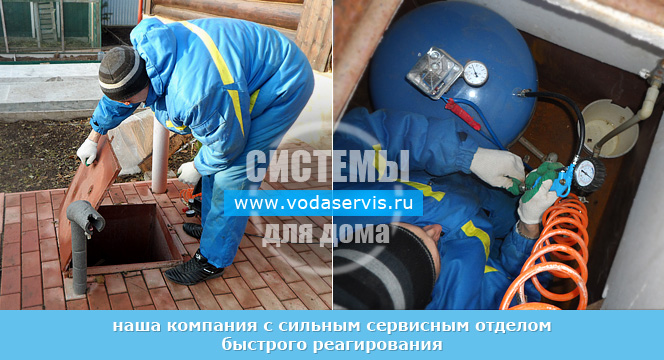
If the pump is selected and installed according to all the rules, and the problem with a lack of water when using several water consumers at the same time still arises, then most likely the water treatment system filter or pipes are clogged well pump. Solve similar problems for you Service specialists will help.
3. Lack of water
The most likely cause of this problem is a malfunction of the well pump. This does not mean that the pump has failed. You may need to change the fuse or check circuit breaker in the electrical panel and turn it on. You can fix these problems yourself.
If the pump itself breaks down, then you cannot do without the help of a specialist. At a minimum, work on dismantling a pump from a well requires special equipment and certain skills. Pump failure can be caused by improper installation, so do not trust the construction of a water supply system to inexperienced organizations.
It is quite difficult to determine on your own the cause of unstable operation or failure of the water supply system in your home. If you are not sure what exactly caused the problem with the water supply, invite a specialist, because do-it-yourself repair water supply system can lead to larger and more expensive repairs.


